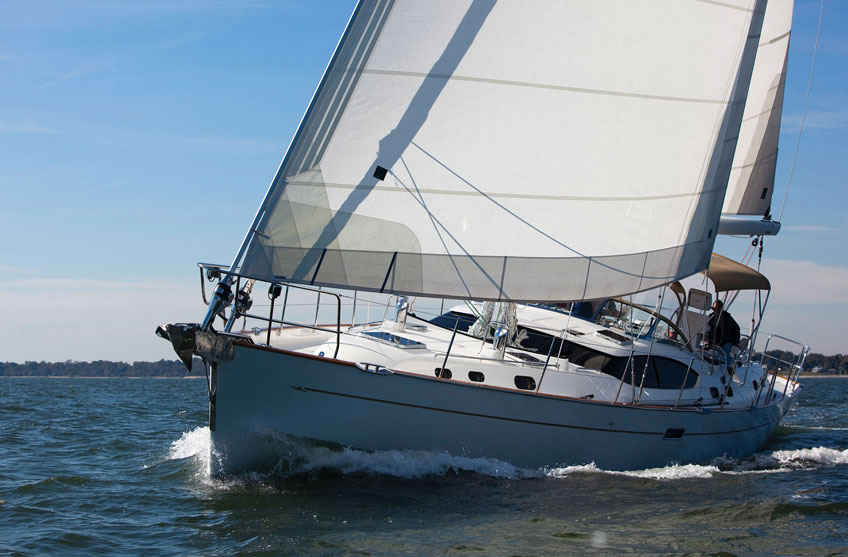Everything you've wanted to ask about Quantum's line of sustainability-manufactured Dacron and Tri-Radial sails.

In 2023, Quantum launched a line of sails manufactured from reclaimed and recycled materials, using lamination processes that reduce environmental impact. Naturally, with any new product come questions from our customers and even our sailmakers about issues like durability and performance, especially compared to the high-quality sails we're already known for. We're here to answer a few FAQs about our new EcoSeries Sails — if you have other questions, don't hesitate to contact your local Loft!
How exactly are EcoSeries Sails helping the environment?
EcoSeries sails are manufactured from diverted trash and plastic, recycled fibers, and use lamination processes that are kinder to the environment. This means less material goes into landfills (or, as we all know, the ocean), and fewer chemical pollutants are released into the water and air. We offer three different cruising options in our EcoSeries Line. The EcoCross is a classic crosscut sail made with up to 100% recycled materials and diverted plastic. The EcoTriCruise is a cruising tri-radial sail made from 100% recycled plastic bottle material and manufactured without polluting solvents or PFAS chemicals. The Fusion M Taffeta EcoSkin is made from 100% recycled fibers. Together, these three products provide a range of options to fit any boat or program looking to turn their inventory more green.
What testing was done with the materials to ensure that it meets Quantum's performance standards?
Our EcoCross, EcoTri Cruise, and EcoSkin are held to the same high standards as any other material we bring into our Lofts and our manufacturing process. Our emphasis is on sustainability without sacrificing performance. Fiber manufacturers have only recently caught up with the demand for this type of product, which is why Quantum launched our EcoSeries sails just last year. We partnered with Challenge, a cloth manufacturer, to make these sails possible and had Alden Simonds at Challenge walk through the process:
The material undergoes multiple stages of testing before it reaches the Loft floor. First, the fiber manufacturers test the raw fibers for durability and tensile strength. Then, those fibers are shipped to Challenge, where they are again tested before being made into cloth.
After the cloth is manufactured, the team at Challenge does a visual inspection both with humans and a computer program to look for flaws and issues — a broken or missing yarn, for example. Then, perhaps more importantly, it goes through a tensile strength test using several different points on one cloth — one bias strip (diagonal), one warp strip (up and down), and one fill strip (across). Finally, the cloth is put through what Simonds describes as an 'abuse test,' or a 'flutter test,' simulating movement in the material to see how it holds up — using motions that simulate tacking and other usual sail movements. The strength is then again measured to ensure it meets standards.
"The [EcoSeries cloth] holds up just the same as regular cloth," says Simonds.
"The final test is every lot; we put our actual hands on it, looking for tearing, pliability, etcetera, anything testing machine can't test," says Simonds. From there, the bolts are sent to Quantum Lofts where they're made into sails for our customers.
What is the cost difference between an EcoSeries sail and a more standard sail?
The short answer: not much
The longer answer: it depends on the type of sail (genoa, main, jib) and the boat, as well as the material — the EcoCross or the EcoTri Cruise.
The longest answer: Jelmer Bouw at our Netherlands Loft estimates the cost difference between a sail made with standard CrossCut Dacron and an EcoCross material is around between five and 15% more expensive for the EcoSeries cloth. The cost difference for the tri-radial EcoSeries cloth (EcoTri Cruise) is approximately the same cost as other tri-radial laminates — and as Bouw points out, the material is sometimes even cheaper when compared to a cloth of the same quality.
Simonds speculates that in the next decade, more, if not all, dacron will be made from recyclable materials. That demand will help drive the cost down – likely to even, or less, than more traditionally manufactured materials.
How do I get a quote for an EcoSeries sail?
Quantum Lofts worldwide can work with you to design and manufacture an EcoSeries sail to fit the needs of your cruising or performance cruising boat. Reach out to your local rep to start the conversation!
When developing these sails for Quantum, it was pivotal that we find materials that would adhere to our sustainability goals without sacrificing performance. With the EcoSeries sails, we've done just that. We hope you'll consider these options for your next Quantum sail.